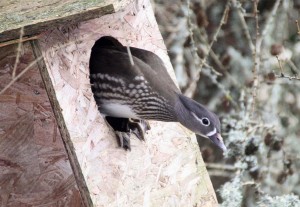 It is still not too late to make last minute changes or refurbishments to nestboxes in the garden. This is despite the fact that there are plenty of birds now singing or displaying. Some of the most active birds are the starlings and recent reports of a cuckoo calling at Spean Bridge may well have been just this bird. Starlings are well known for their mimicry and will imitate not only other birds but also any notes, even a telephone ringing! These attractive birds are not only singing but also going into their nest holes where they are often colonial nesters with a few pairs breeding close to each other. Starlings lay bright blue eggs with no markings. Occasionally small pieces of bright blue eggshell can be found under their nests having been discarded by the adults once the chicks have hatched.
It is still not too late to make last minute changes or refurbishments to nestboxes in the garden. This is despite the fact that there are plenty of birds now singing or displaying. Some of the most active birds are the starlings and recent reports of a cuckoo calling at Spean Bridge may well have been just this bird. Starlings are well known for their mimicry and will imitate not only other birds but also any notes, even a telephone ringing! These attractive birds are not only singing but also going into their nest holes where they are often colonial nesters with a few pairs breeding close to each other. Starlings lay bright blue eggs with no markings. Occasionally small pieces of bright blue eggshell can be found under their nests having been discarded by the adults once the chicks have hatched.
Chaffinches are now in full song and the greenfinches are calling with their odd sounding “wheezing” notes that you do not expect from such a small rotund bird. In contrast the flocks of siskins are still coming to garden feeders and their high pitched tinkling notes are very musical and attractive. As for the hole nesting birds, the blue tits seems to spend more time closer together although still coming regularly to the feeders after peanuts. Great tits are behaving in the same way and their double call notes that sounds like “Teacher, teacher” seem everywhere. Both the great and blue tits will have already investigated their future nesting sites but will not have been taking in any nest material yet.
As for my checking of nestboxes, most of them have been satisfactory although a few needed attention. One had problems over the lid and needed two new hinges and clasps to hold the lid down securely in time of high winds. This is a triple box designed to take three pairs of house sparrows as there are three entrance holes and compartments. House sparrows have never looked at this nestbox, as far as I am aware, but last year one end of the box was used by a pair of blue tits who successfully reared young. This year I have been putting wood chippings into the bottom of the boxes as I am sure that this encourages birds to utilise the box as if the chippings are a start to their complex nest building.
There is always competition for nest sites and perhaps even more so with the larger boxes. One such design is meant to cater for the local resident wild mandarin ducks and already they have been investigating the two large nestboxes I can see from my study window. The photograph shows a female mandarin looking out. They will still stand a chance as the early nesting tawny owl seems to be totally absent this year. These woodland owls are so early they often have eggs before the mandarin ducks try to find a suitable box. Another competitor is the jackdaw and, on rare occasions, goosanders and starlings have been known to use such boxes, such is the intense competition for such holes.
Such competition is found in surprising ways and this has been the case with the house martin nests under the eaves of the house. A few years ago it was noticed that the house martins were being ejected by the more belligerent house sparrows. The house sparrows would wait until the house martins had half built their nests then take over. One solution was the artificial house martin nestboxes but not all the house martins use them as some pairs will still insist on building their own.
